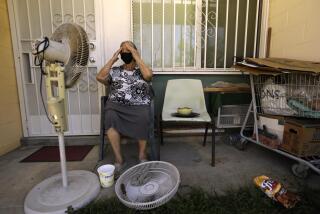HOMESTYLE / Screens : Stylish Ways to Let Cool Air In, Bugs Out
North Countyâs mild climate and gentle breezes make keeping a house open to the outdoors almost irresistible.
Although the fresh air is welcome, the flying insects that arrive with it usually are not. Now that cooler weather has lowered the number of bugs seeking air rights in your home, theyâre apt to be one of the last things on your mind.
But, just as spring and summer are good times to have your furnace checked, fall and winter are good times to come to terms with the condition of the screens on your windows and doors. During the warmer months, when insects are in their heyday, screen companies are busy and might be delayed in getting to your house.
Some folks eschew screens. They would rather deal with the buzzing consequences than have their view obstructed, their air flow limited or the appearance of their home marred.
But new colors and materials are making screens an increasingly subtle addition to a home. You may only know theyâre there by the lack of unwanted tiny visitors.
There are two parts to a screen: the frame and the screen itself.
Traditional frames and screens are made of gray aluminum; you often find these on older homes.
According to Steven Cannady, owner of Steveâs Screens in Carlsbad, aluminum frames finished in white or bronze, which looks black, are more popular now. White frames make an especially good match with Cape Cod-style homes.
While some companies sell frames of 1/4--inch aluminum, Cannady recommends at least 3/8-inch grade.
It used to be that screens were all aluminum, but fiberglass has become a popular alternative.
âAt the coast, most people use fiberglass, which doesnât corrode,â Cannady said. âIt comes in standard gray or black. The advantage with black is that it doesnât look like anythingâs there. Black absorbs light, but lighter colors reflect it. So I often recommend black, especially where there are views.â
However, black screens can create a hazard when used to cover large openings. Since they are nearly invisible, especially at night, people sometimes walk into them. If black screens are used for large door openings, small decorations can be hung on them.
Some fiberglass screens have disadvantages, according to Joe Orlando, owner of Coast Screen in Encinitas: for one thing, the holes in them are smaller, so they donât allow as much air flow as aluminum screens. For another, they can cost more.
While some people with pets believe aluminum screens are more durable, animals can tear up just about any screen, Cannady said. Grills covering the bottom half of screen doors can protect them from pets.
When comparing screens, take a good look at the mechanism that attaches the screen to the window. Make sure the system is durable and allows easy removal of screens when itâs time to clean windows.
Screens have a life expectancy of two to five years along the coast, 10 years or more inland. Where screens are damaged beyond repair but frames are in good condition, screen companies can re-screen old frames, saving you money.
While shopping for screens, also consider tinting windows that get heavy sun exposure. Many screen companies also do tinting. Tinted windows reduce glare and protect carpets and furniture from direct sun.
If you are remodeling or building a new home, there are ways to make screens less conspicuous.
Rancho Santa Fe architect Ken Ronchetti tucks large sliding glass doors and screens into wall pockets. Screens can be rolled out of sight when not needed.
In rooms with views, Ronchetti places ventilating windows and their accompanying screens up high, where they wonât obstruct views. Or, across some walls, he alternates operable ventilating windows with fixed view windows.
Some of Ronchettiâs houses have large covered patios. He keeps insects out by using large swatches of mosquito netting suspended from overhead tracks. Ronchetti buys the material at Upholstery Fabric Outlet in Vista.
On small homes, especially those without air conditioning, front doors can serve an important ventilating role and will need screens. Larger homes have other sources of ventilation, so their front doors wonât need screens, Ronchetti said.


